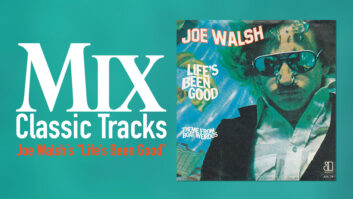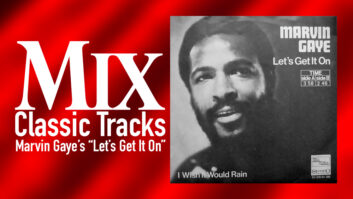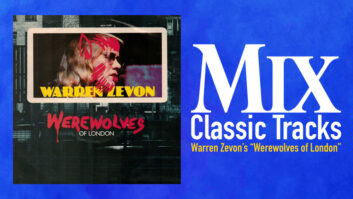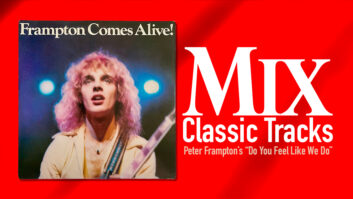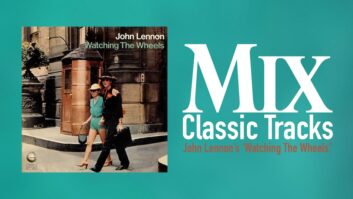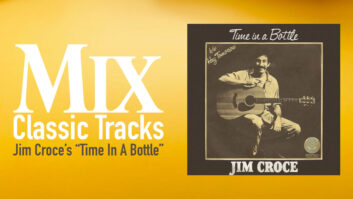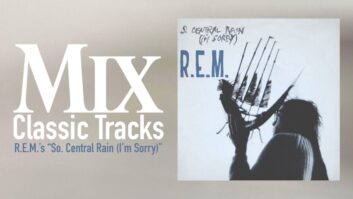The creator of this month’s quirky Classic Track from 1983 was born Thomas Morgan Robertson on October 14, 1958, in Cairo, Egypt. (He’s the son of a British archeologist.) He became intrigued with music and technology at a young age, and by the time he was 18, he was building his own synthesizers. Robertson went to college to study meteorology and was nicknamed Dolby by schoolmates for his outside interests, and the nickname stuck. By 1979, Dolby founded the Camera Club with Bruce Wooley, Trevor Horn and Geoff Downes. After leaving that group, he joined Lene Lovich’s band and wrote the hit song “New Toy.” Dolby continued writing songs for others and producing artists before he began his solo career in 1981. He recorded singles that became minor hits in the UK, and on the strength of that released his first solo album, The Golden Age of Wireless, in May 1982.
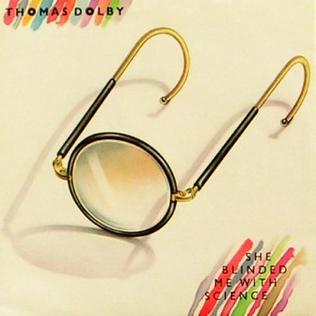 Dolby remembers that in the songwriting process for “She Blinded Me With Science,” “The first thing I got was the title—that sometimes happened with my songs. The next thing that happened was the groove, and then I fleshed it out, partly from the cinematic implications. I started thinking about the video quite early on, and at that point I had put out a couple of singles that had videos associated with them, and I was getting ready to write and direct my own. I was very interested in that genre, so I was thinking cinematically from the get-go. And I had a strong sense that this was the era of Adam Ant and Simon Le Bon and Sting and so on, and I wasn’t a poster child in that sense. But on the other hand, the sort of slightly forlorn mad scientist character was somewhat endearing to people and was definitely a part of my personality and one I probably inherited from my dad, who is the real thing. And so I decided I was going to create a vehicle for that character. And that’s what the song and the video were.”
Dolby remembers that in the songwriting process for “She Blinded Me With Science,” “The first thing I got was the title—that sometimes happened with my songs. The next thing that happened was the groove, and then I fleshed it out, partly from the cinematic implications. I started thinking about the video quite early on, and at that point I had put out a couple of singles that had videos associated with them, and I was getting ready to write and direct my own. I was very interested in that genre, so I was thinking cinematically from the get-go. And I had a strong sense that this was the era of Adam Ant and Simon Le Bon and Sting and so on, and I wasn’t a poster child in that sense. But on the other hand, the sort of slightly forlorn mad scientist character was somewhat endearing to people and was definitely a part of my personality and one I probably inherited from my dad, who is the real thing. And so I decided I was going to create a vehicle for that character. And that’s what the song and the video were.”
Dolby had a sequence running in his home studio and sang over it and put it down on cassette as a demo. Next, he met with prospective producers, and ended up choosing Tim Friese-Greene to help co-produce the song.
“She Blinded Me With Science” and “One of our Submarines” were both recorded in one week at Mayfair Studios in London. At that time, the studio was equipped with a 24-track analog 2-inch and an MCI mixing board. Most of “Science” was recorded on synthesizers. A Moog Source synth played by Dolby’s bass guitarist, Matthew Seligman, was used for the prominent bass lines. Instead of going direct, however, Friese-Greene fattened up the synthesized sounds by feeding them out to Seligman’s miked bass amp in the studio.
The Source was also used for some top-line parts, but the majority of the keyboard parts were played on a Roland JP-4. The ominous-sounding strings were also created on the JP-4, using four tracks two octaves apart, stereo left and right. The horns in the chorus were from the Roland, but the Source was used again for a piccolo trumpet line which, Dolby believes, “subliminally gives it some air, instead of everything being so tight in the same register. In the same way you could use a piccolo or a trumpet in a brass section in unison, but a couple of octaves up.”
The sample-and-hold feature on the Moog was responsible for the tinkling bell sounds at the beginning of the song, and the Source also made the descending “phone” part after the chorus. This was achieved, Dolby says, “by putting the resonance all the way up on the filter and turning off the oscillators, so when you play, all you hear is the resonance of the filters. If you double that up, you can tune it to intervals, but it doesn’t really play in a precise tonality across the keyboard.”
Dolby’s drum machine on the track was a PPG unit (originally designed to work Tangerine Dream’s light show) connected to a set of Simmons drums. He reports: “It played them in a unique way; it had a short gate time on the voltage it put out, and it made it sound different from the hexagonal pads that were very symptomatic of that era.” The PPG drum module allowed the user to tune the playback sample rate, and on “Science” the snare drum was detuned three or four octaves to give it that “cracky” sound. The kick and snare are Simmons, and the cowbell playing on the offbeats was generated from the PPG. The tom-toms are from the Simmons module fed through the bass amp. The output of an Eventide Harmonizer was used for the strange rising and falling pitch at the end of the song. “Tim Friese-Greene hopped on my rig and programmed a rim shot that he wanted to use as a sound source for a part,” Dolby says. “And he probably had to pre-delay it a fair amount, because the Harmonizer added quite a lot of delay.”
Dolby’s lead vocals (which he terms “theatrical”) were recorded using a Neumann u87. There were only two takes of the vocal, one of which was used with no editing. The unusual flanging sound on the backing vocals was actually a result of doubling the vocals (sung by Mutt Lange and Miriam Stockley) with a violin and a synthesizer. Magnus Pyke, who contributed the odd speaking parts, used the same miking setup as Dolby. A celebrity TV scientist in the UK, Pyke was a very stubborn and awkward character, and agreed to do the project only after considerable cajoling. Dolby remembers, “When he was working with me in the studio, I would say, ‘Dr. Pyke, when I wave my hand you say: “She blinded me with science!”‘ And on the first few he did; he said, ‘She blinded me with science?’ And I said, ‘That’s great, but it’s not really a question; it’s like an exclamation.’ And he goes, ‘Yes, but as a known scientist it would be a bit surprising if a girl blinded me with science.’ The tape was rolling and that’s what leads in the 12-inch. Every time he went to the u.S. afterwards people would come up behind him and yell, ‘Science!’ And it drove him absolutely bonkers.”
Dolby recalls fondly that mixing in those days had a nice liveness to it: “When we ran a mix, there would often be several people in the control room: The tape op had to be in charge of making sure the Revox tape delay was rewound and that it wasn’t going to run out of tape in the middle of the take. And somebody else would be monitoring the desk, and his precise job was to switch on channels 1-12, but only after the guitar kicks in, because otherwise you would hear the noise. It was very exciting doing a mix in those days. It was a performance. You’d take a deep breath and say, ‘Guys, I’ve got a good feeling about this next one.'”
There was a single marathon session to mix the 7-inch versions of “Science” and “Submarines”; 20 hours later they began working on the 12-inch of “Science” (which is probably the best-known version) and managed to mix it in a mere three hours. Dolby says, “In spite of the constraints, we managed to come up with something that sounded pretty good. So, in a way, I get more stimulation out of working within a set of constraints like that than when you have unlimited choices.”
Dolby wrote and directed the famous video for the song, which was shot in one day and cost just u10,000. The whole process on the song from pre-production to finished video took a month, and it became a very wise investment for Dolby and his record company-MTV and dance clubs jumped on the song, and it took off quickly on the radio. It became so popular, in fact, that Capitol decided to repackage Dolby’s first album, The Golden Age of Wireless, with the new tracks. When the album was initially released, it sold about 40,000 copies; when re-released with “Science,” it went to more than 700,000 in its first year. The single shot up the chart to Number Five (u.S.), and the album went to Number 13.
After recording music for many years, Dolby became involved with a group of composers and sound designers creating music for video games and virtual reality systems. once known as Headspace, the Silicon Valley-based company changed its name to Beatnik this year; Dolby, who now goes by Thomas Dolby Robertson, is the president/CEO. Beatnik has also been involved in a number of educational programs and recently sponsored a contest, with the Ex’pression Center for New Media in Emeryville, Calif., in which students were given the chance to remix “She Blinded Me With Science,” using both new and original elements in different combinations. As Dolby says, “It’s kind of music with training wheels. My 4-year-old could do a mix, and it still sounds pretty good.”
